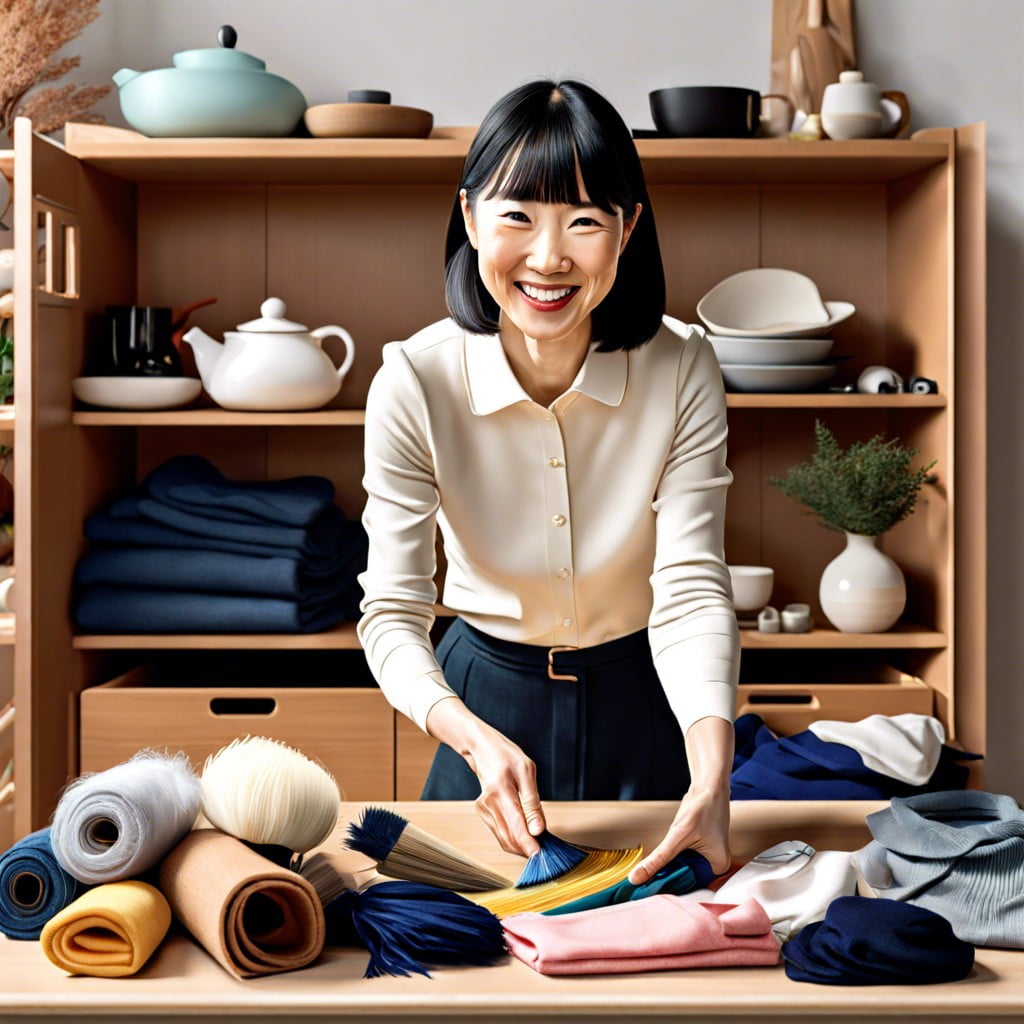Last updated on
Discover how Marie Kondo’s KonMari method can transform your home into a clutter-free sanctuary by focusing on keeping items that “spark joy.
Key takeaways:
- Spark joy by keeping only items that make you happy.
- Sort items by category, not location, for effective decluttering.
- Follow the right sequence: start with clothes, then sentimental items.
- Assign a home for each item and treat them with respect.
- Tidying up can have environmental and psychological benefits.
Table of Contents
Development of the KonMari Method

Marie Kondo began developing her tidying method as a teenager in Japan, a quest fueled by a passion for organizing shared by few her age. This personal endeavor evolved into the KonMari method, a unique system centered around keeping only items that “spark joy.” Rather than focusing solely on reducing clutter, her approach integrates mindfulness, introspection, and forward-thinking, aiming to affect not just physical spaces but the overall lifestyle of her followers.
Her journey from enthusiast to expert was marked by trials, errors, and continuous refinement. A critical moment was realizing that tidying should be done by category, not location, fundamentally shaping her method’s development. This insight led to her distinctive folding techniques, designed not only to save space but also to respect belongings and their role in one’s life.
By combining traditional Japanese values with practical success strategies, she created a method that emphasizes harmony between living spaces and those dwelling in them.
Key Principles of the KonMari Method
Marie Kondo’s tidying philosophy hinges on a few core principles that can transform both your home and your outlook on possessions.
First up, the joy check: hold each item individually and ask yourself, “Does this spark joy?” If not, it might be time to part ways. This simple question encourages emotional attachment to items, ensuring you’re surrounded only by things that make you happy.
Next, category triumphs over location. Instead of decluttering room by room, the method sorts items by category – clothes, books, papers, komono (miscellaneous items), and sentimental items. This approach prevents the common pitfall of shuffling items from one room to another without real decluttering progress.
Once you begin sorting, follow the right sequence. Start with clothes, which are typically easier to assess for joy-sparking qualities, before moving onto more emotionally charged categories like sentimental items. This order helps you hone your decision-making skills as you progress.
Finally, cherish everything you decide to keep. Assign a home for each item and treat them with respect by folding clothes in Marie’s distinctive upright style or creatively displaying other cherished items.
By adhering to these principles, not only will your living space thank you, but your newfound clutter-free environment may just improve your overall wellbeing. And who knows, folding clothes might just become your new party trick!
Impact of “The Life-Changing Magic of Tidying Up”
When “The Life-Changing Magic of Tidying Up” hit the shelves, it didn’t just sell copies—it launched a decluttering crusade. People worldwide began thanking their socks for their service before bidding them goodbye. The book’s appeal lies not only in its unique tidying method but also in its gentle philosophy that ties decluttering to personal joy.
Marie Kondo’s approach transformed tidying from a daunting chore into a reflective practice, promoting the idea that we should only hold onto items that “spark joy.” This simple criterion forced many to reconsider their relationships with material possessions and significantly reduce the volume of items in their homes.
The profound effect wasn’t confined to personal spaces. Retailers saw shifts in buying behaviors with increasing demand for organizing tools and products, while thrift stores and donation centers experienced an influx of contributions. This book managed to make tidying up trendy, mindful, and almost spiritual, and opened up discussions on how living with less can lead to more happiness and fulfillment.
Transition From Book to Netflix Series
Marie Kondo expanded her reach beyond the pages of her book by landing a deal with Netflix. The show, “Tidying Up with Marie Kondo,” became a cultural phenomenon when it premiered in 2019. It visually brings to life her tidying methods, presenting her direct engagement with cluttered households. Viewers could now see the practical application of her methods, adding a visual and emotional layer to her already popular teachings.
Each episode works its way through different homes, showcasing real-life challenges and transformations. This not only entertained but also educated audiences on the benefits of decluttering. The series succeeded in amplifying the interest in her methods, turning tidying from a mundane chore to an almost therapeutic activity that could be shared with family or enjoyed solo with a cup of tea and perhaps too many throw pillows.
Environmental and Psychological Benefits of the KonMari Method
When you embrace the KonMari method, you’re not just tidying up your home; you’re also contributing positively to the environment. Fewer items in your space mean less consumption and waste, aligning beautifully with sustainable living principles. As you let go of unnecessary belongings, consider donating them, which helps reduce landfill waste and supports those in need.
Psychologically, this method does wonders. Clutter is often linked with increased stress and anxiety. By choosing to keep only those items that “spark joy,” you’re essentially curating a personal environment that promotes mental clarity and peace. This selective process can also boost decision-making skills and confidence, as you continually practice discerning what truly matters in your surroundings and in life.




